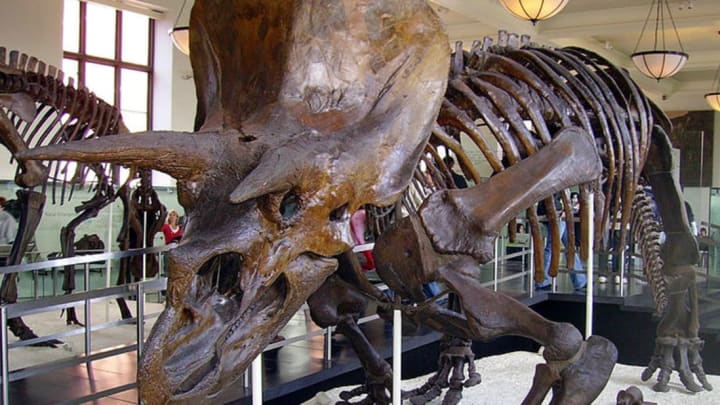Dinosaurs are still with us. They’ve stomped, chomped, and roared their way into our movies, our museums, and our imaginations. So let’s get ready to dig a little deeper. Today, we’re taking a closer look at everyone’s favorite three-horned herbivore, Triceratops.
1. It’s the Official State Fossil of South Dakota
And lest anyone fear that Triceratops is still underappreciated, the creature is also Wyoming’s “State Dinosaur” (and, yes, that’s a separate category).
2. Those Distinctive Horns Changed Shape with Age
Scientists have found that baby Triceratops had short, stubby horns. Over time, these began curving backward before pointing in the opposite direction and assuming their familiar form once their owner hit adulthood. Skip to the 12:10-mark in this awesome TED talk for more details:
3. Triceratops Duels Could Get Rather Nasty
These beasties had a knack for collecting battle scars—in a few very specific locations! Distinctive wounds are often found near the eye sockets and the base of the frills in Triceratops skulls. Why there? According to research conducted in 2009, the injuries were likely caused by adults locking their horns in combat.
4. T. rex Couldn’t Resist Nibbling on Triceratops Faces
Thanks to some tell-tale bite marks, we know that not only would a hungry Tyrannosaurus sink its teeth into the occasional hunk of Triceratops, but the predator would frequently target its delicate facial tissue in the process (though less-meaty regions of the skull were largely ignored).
5. The Price of a Decent Triceratops Skull has Gone Through the Roof
Getty Images
Not even dinosaurs are inflation-proof. In 1997, the average Triceratops skull (harvested by fossil collectors) cost roughly $2500. Nowadays, museums and private dinosaur-fanciers alike generally have to shell out well over ten times as much to get their hands on one!
6. Triceratops Had Good Posture
Old paintings depict Triceratops’ front legs sprawling out to the side, similar to those of a modern crocodile. However, a re-analysis of its elbow joint showed that the beast maintained an upright, rhinoceros-like gait instead.
7. Triceratops Was Originally Mistaken for an Overgrown Bison
During the American Gilded Age, paleontologist Othneil Charles Marsh received a pair of fossilized horn fragments which he thought belonged to a giant, prehistoric bovine. But subsequent discoveries from the area convinced him that what he’d found was, in fact, a dinosaur, which Marsh eventually named “Triceratops” (meaning “Three-Horned Face”).
8. In 1889, Somebody Actually Tried Lassoing A Triceratops.
While exploring the badlands of Wyoming, one of Marsh’s associates—a brilliant scientist named John Bell Hatcher—was approached by a rancher who’d spotted a huge, mysterious skull on his property. It turned out to have been one of the very first Triceratops specimens ever discovered. Oblivious to its significance, the cattleman attempted to haul off his treasure by throwing a lasso over one of its horns … which promptly snapped off.
9. Triceratops’ Head Was Nearly One-Third the Length of Its Body
No doubt about it: Triceratops had one heck of a noggin, which could stretch 2.5 meters (8.2 feet) from end to end. By comparison, the critter’s entire body reached a total length of around 8 meters (26.25 feet).
10. Its Name Was Wrongly Pronounced “Dead” By the Media
Let the record show—once and for all—that while Triceratops may be extinct, its scientific name isn’t going anywhere. Why bring this up? For several years, the press has been erroneously claiming that Triceratops Never Existed.
The confusion began in 2010, when paleontologist Jack Horner co-authored a paper in which he argued that Triceratops and Torosaurus (a related dino) were really one and the same. No organism can (academically) go by two monikers, so, if Horner turns out to have been right, one of these titles would have to be discarded. But, have no fear, fellow fossil nerds! The more recognizable name was coined two years earlier and, hence, has seniority. So, we might lose Torosaurus, but we’ll still have Triceratops!
